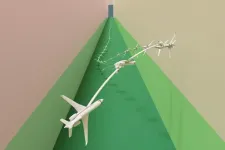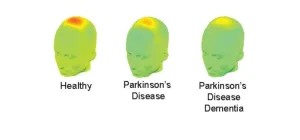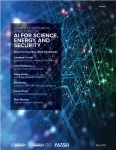(Press-News.org) Scientists affiliated with the National Space Research Institute (INPE) in Brazil have combined models that predict urban expansion and land-use changes with hydrodynamic models to create a methodology capable of supplying geographical information that identifies flood-prone areas of cities, especially those vulnerable to the impact of extremely heavy rainfall.
The groundbreaking study was based on data for São Caetano do Sul, a city in metropolitan São Paulo, but the methodology can be used by other cities to devise public policies and make decisions in addressing the impacts of these phenomena in order to avoid deaths of residents and destruction of buildings and infrastructure.
The study was funded by FAPESP via two projects (20/09215-3 and 21/11435-4). Preliminary results are reported in an article published in the journal Water. They were part of the PhD research of Elton Vicente Escobar Silva, first author of the article and a researcher at INPE.
In partnership with the Federal University of Paraíba (UFPB) and the Federal University of Rio Grande do Sul (UFRGS), and with local bodies, the researchers “tested” the modeling methodology using civil defense data for the city relating to a flood that occurred on March 10, 2019, when three people drowned and the floodwaters reached a depth of almost 2 meters in several streets.
“I’ve worked with modeling for years, focusing on changes in land use and cover in urban areas. I wanted to combine this with flood simulation. The opportunity arose in connection with Elton’s project,” Cláudia Maria de Almeida, joint first author of the article and Silva’s thesis advisor, told Agência FAPESP. She is also a researcher at INPE, where she heads the institute’s urban remoting sensing unit (CITIES Laboratory).
“The study innovated by combining hydrodynamic modeling for urban areas with the complexity of the underground runoff drainage network, and by using real data to calibrate and validate the model. We combined very high-resolution spatial imaging and deep learning. All this is linked to big data and smart cities,” she said.
Discussion of smart cities began in 2010, initially involving technological issues such as integrated traffic light control systems and bus stops with Wi-Fi. Sustainability and quality of life for residents have been included more recently.
According to the United Nations, the world population reached 8 billion in 2022, with 56% living in urban areas. The population is expected to rise to 9.7 billion by 2050, with 6.6 billion (68%) living in cities.
Cities are currently expanding at twice the rate of population growth. In the next three decades, urban areas worldwide are set to total more than 3 million square kilometers, equivalent to the territory of India.
City planning is not advancing at the same pace. For example, rampant urbanization incurs changes in land use and cover, expands impermeable surfaces and alters hydrology. In conjunction with the higher frequency of extreme weather events due to climate change, this exposes cities to flooding and landslides in the rainy season.
Cross-tabulation
For hydrodynamic modeling, the researchers used a software package called HEC-RAS (Hydrologic Engineering Center’s River Analysis System), which simulates water flow and surface elevation, as well as sediment transport.
To identify flood-prone areas, they used two digital terrain models (DTMs) with different spatial resolutions of 0.5m and 5m. A DTM is a mathematical representation of the topography of the Earth’s surface, excluding all vertical objects. The model can be manipulated by computer programs and is typically visualized as a grid in which an elevation value is assigned to each pixel. Vegetation, buildings and other characteristics are digitally removed. In this study, the researchers used four computing intervals (1, 15, 30 and 60 seconds) in their analysis of the simulations.
The best results were obtained from the simulations with a spatial resolution of 5m, which displayed maps with the highest coverage of flood-prone areas (278 out of 286 points, or 97.2%) in the shortest computation time. They identified potential for flooding in areas not detected by civil defense authorities or citizens of São Caetano do Sul during actual flood events.
“We set out to create a methodology to support decision-makers. We simulated projected land-use changes several years ahead and their impact on the network of watercourses. On this basis, it’s possible to run simulations with scenarios. An example would be specifying millimeters of rain in a given timeframe to predict the impact on an area of a city in terms of flooding. Public administrators can use this capability to make decisions, avoiding economic damage as well as loss of life,” Silva said.
The researchers stressed the need for cities to update their databases for this type of analysis, as did São Caetano do Sul. “The model works with and is fed by data. It’s important for cities to have up-to-date information, including records relating to extreme cases, such as major floods and inundations,” Almeida said.
São Caetano do Sul is part of a dense conurbation that encompasses São Paulo city as well as the neighboring cities of Santo André and São Bernardo do Campo. It has had many floods and inundations – 29 between 2000 and 2022 alone, according to the researchers.
On the other hand, it ranks first among all 5,570 municipalities in Brazil for sustainability based on the Sustainable Development of Cities Index – Brazil (IDSC-BR), part of a series of reports produced by the United Nations Sustainable Development Solutions Network (SDSN) to monitor implementation of the Sustainable Development Goals (SDGs) in member countries.
With some 162,000 inhabitants, it has a comprehensive wastewater treatment system connected to 100% of homes. Almost all urban dwellings (95.4%) are located on public streets with trees, and reasonably large proportion (37%) on adequately urbanized streets (paved and with sidewalks, curbs and drains), according to IBGE, Brazil’s census and statistics bureau.
About São Paulo Research Foundation (FAPESP)
The São Paulo Research Foundation (FAPESP) is a public institution with the mission of supporting scientific research in all fields of knowledge by awarding scholarships, fellowships and grants to investigators linked with higher education and research institutions in the State of São Paulo, Brazil. FAPESP is aware that the very best research can only be done by working with the best researchers internationally. Therefore, it has established partnerships with funding agencies, higher education, private companies, and research organizations in other countries known for the quality of their research and has been encouraging scientists funded by its grants to further develop their international collaboration. You can learn more about FAPESP at www.fapesp.br/en and visit FAPESP news agency at www.agencia.fapesp.br/en to keep updated with the latest scientific breakthroughs FAPESP helps achieve through its many programs, awards and research centers. You may also subscribe to FAPESP news agency at http://agencia.fapesp.br/subscribe.
END
Experiment in Brazil identifies flood-prone areas of cities
The study combined models that predict urban expansion and land-use changes with hydrodynamic models, and the results were validated using actual data for São Caetano do Sul, a city in metropolitan São Paulo.
2023-06-12
ELSE PRESS RELEASES FROM THIS DATE:
Updating cars as fast as a smart phone
2023-06-12
Cyber-physical systems, such as vehicles, trains, airplanes, smart homes, or production facilities, combine electronic and mechanical elements with software. Development of these systems is highly complex due to the large number of dependencies among the components. “When a car’s wire harness is modified, the diameter of the cable duct also has to be changed,” says Professor Ralf Reussner, Spokesman of the CRC at KIT. This must be agreed upon by electrical engineers, software engineers and mechanical engineers. ...
Excessive alcohol consumption may accelerate Alzheimer’s disease progression
2023-06-12
LA JOLLA, CA—Alcohol use disorder (AUD) quickens the pace of Alzheimer’s disease progression when paired with genetic susceptibility. Scripps Research and University of Bologna scientists reported in the journal eNeuro on June 12, 2023, that repeated alcohol intoxication is associated with changes to gene expression indicative of disease progression in the brains of mice that are genetically predisposed to Alzheimer’s. When repeatedly exposed to intoxicating amounts of alcohol, ...
A step toward safe and reliable autopilots for flying
2023-06-12
In the film “Top Gun: Maverick,” Maverick, played by Tom Cruise, is charged with training young pilots to complete a seemingly impossible mission — to fly their jets deep into a rocky canyon, staying so low to the ground they cannot be detected by radar, then rapidly climb out of the canyon at an extreme angle, avoiding the rock walls. Spoiler alert: With Maverick’s help, these human pilots accomplish their mission.
A machine, on the other hand, would struggle to complete the same pulse-pounding task. To an autonomous aircraft, for instance, the most straightforward path toward the target is in conflict with what the machine needs ...
Mass General Hospital researchers uncover why light-to-moderate drinking is tied to better heart health
2023-06-12
BOSTON – A new study led by investigators from Massachusetts General Hospital, a founding member of the Mass General Brigham healthcare system, offers an explanation for why light-to-moderate alcohol consumption may be associated with lower risk of heart disease. For the first time, researchers found that alcohol, in light to moderate quantities, was associated with long-term reductions in stress signaling in the brain. This impact on the brain’s stress systems appeared to significantly account for the reductions in cardiovascular events seen in light to moderate drinkers participating in the ...
NIH grant backs study focused on Alzheimer’s in women
2023-06-12
HOUSTON – (June 12, 2023) – Two-thirds of the people suffering from Alzheimer’s disease are women, yet most research has ignored differences between the sexes.
To help fill this gap, Rice University postdoctoral fellow Hannah Ballard will look at how Alzheimer’s risk, estrogen levels and menopausal status interact with memory-related brain function and behavioral outcomes in women age 35-80.
Supported by a three-year grant from the National Institutes of Health (NIH), Ballard’s research could help identify the physiological factors ...
Self-esteem of kids with short stature tied to social supports, not height
2023-06-12
Philadelphia, June 12, 2023—Challenging the assumption that short stature negatively impacts children and adolescents’ self-esteem, a new study by researchers at Children’s Hospital of Philadelphia (CHOP) has found that in otherwise healthy short youth, quality of life and self-esteem are associated with coping skills and how supported they feel and not the degree of their short stature. The findings were published in The Journal of Pediatrics.
“There is a notion among some parents and caregivers that short stature will negatively impact their children in terms of self-esteem and social adjustment, so they seek out growth hormone ...
Brain waves may predict cognitive impairment in Parkinson's disease
2023-06-12
A few minutes of data recorded from a single electrode placed on top of the head may be sufficient to predict thinking problems, including dementia, in patients with Parkinson’s disease (PD). The finding from a new University of Iowa study might help improve diagnosis of cognitive disability in PD and develop new biomarkers and targeted therapies for cognitive symptoms of the disease.
“Cognitive decline, including dementia, is a significant and underappreciated symptom of Parkinson’s disease. ...
The Face Game: A citizen science project to learn how Artificial Intelligence will choose to appear to humans
2023-06-12
Online, profile pictures of human faces are everywhere, and they play a crucial role in shaping the first impression we make on others. Right now, AI gives people the digital tools to transform their online appearance in any way they desire, often making themselves look younger or more attractive. But this is just the beginning: AI is not only helping us play this face game amongst ourselves, but it is also learning the game from us and quietly deciding which face it will showcase as itself when interacting with us.
To better understand these mechanisms, researchers from the Max Planck ...
Ethics & Human Research, May-June 2023
2023-06-12
Making an Advance Research Directive: An Interview Study with Adults Aged 55 and Older with Interests in Dementia Research
Nola M. Ries, Briony Johnston
Many people with dementia are interested in taking part in research, including when they no longer have capacity to provide informed consent. Advance research directives (ARD) enable people to document their wishes about research participation prior to becoming decisionally incapacitated. However, there are few available ARD resources. This Australian interview study elicited the views of people aged 55 years and older about the content of an ...
Visionary report unveils ambitious roadmap to harness the power of AI in scientific discovery
2023-06-12
Innovations in artificial intelligence (AI) are rapidly shaping our world, from virtual assistants and chatbots to self-driving cars and automated manufacturing. Seizing on the potential of AI to transform science, the nation’s leading experts in science and technology have released a blueprint for the United States to accelerate progress by expanding its capabilities in AI and big data analysis.
“AI for Science, Energy, and Security” lays out a comprehensive vision ...
LAST 30 PRESS RELEASES:
Injectable breast ‘implant’ offers alternative to traditional surgeries
Neuroscientists devise formulas to measure multilingualism
New prostate cancer trial seeks to reduce toxicity without sacrificing efficacy
Geometry shapes life
A CRISPR screen reveals many previously unrecognized genes required for brain development and a new neurodevelopmental disorder
Hot flush treatment has anti-breast cancer activity, study finds
Securing AI systems against growing cybersecurity threats
Longest observation of an active solar region
Why nail-biting, procrastination and other self-sabotaging behaviors are rooted in survival instincts
Regional variations in mechanical properties of porcine leptomeninges
Artificial empathy in therapy and healthcare: advancements in interpersonal interaction technologies
Why some brains switch gears more efficiently than others
UVA’s Jundong Li wins ICDM’S 2025 Tao Li Award for data mining, machine learning
UVA’s low-power, high-performance computer power player Mircea Stan earns National Academy of Inventors fellowship
Not playing by the rules: USU researcher explores filamentous algae dynamics in rivers
Do our body clocks influence our risk of dementia?
Anthropologists offer new evidence of bipedalism in long-debated fossil discovery
Safer receipt paper from wood
Dosage-sensitive genes suggest no whole-genome duplications in ancestral angiosperm
First ancient human herpesvirus genomes document their deep history with humans
Why Some Bacteria Survive Antibiotics and How to Stop Them - New study reveals that bacteria can survive antibiotic treatment through two fundamentally different “shutdown modes”
UCLA study links scar healing to dangerous placenta condition
CHANGE-seq-BE finds off-target changes in the genome from base editors
The Journal of Nuclear Medicine Ahead-of-Print Tip Sheet: January 2, 2026
Delayed or absent first dose of measles, mumps, and rubella vaccination
Trends in US preterm birth rates by household income and race and ethnicity
Study identifies potential biomarker linked to progression and brain inflammation in multiple sclerosis
Many mothers in Norway do not show up for postnatal check-ups
Researchers want to find out why quick clay is so unstable
Superradiant spins show teamwork at the quantum scale
[Press-News.org] Experiment in Brazil identifies flood-prone areas of citiesThe study combined models that predict urban expansion and land-use changes with hydrodynamic models, and the results were validated using actual data for São Caetano do Sul, a city in metropolitan São Paulo.





